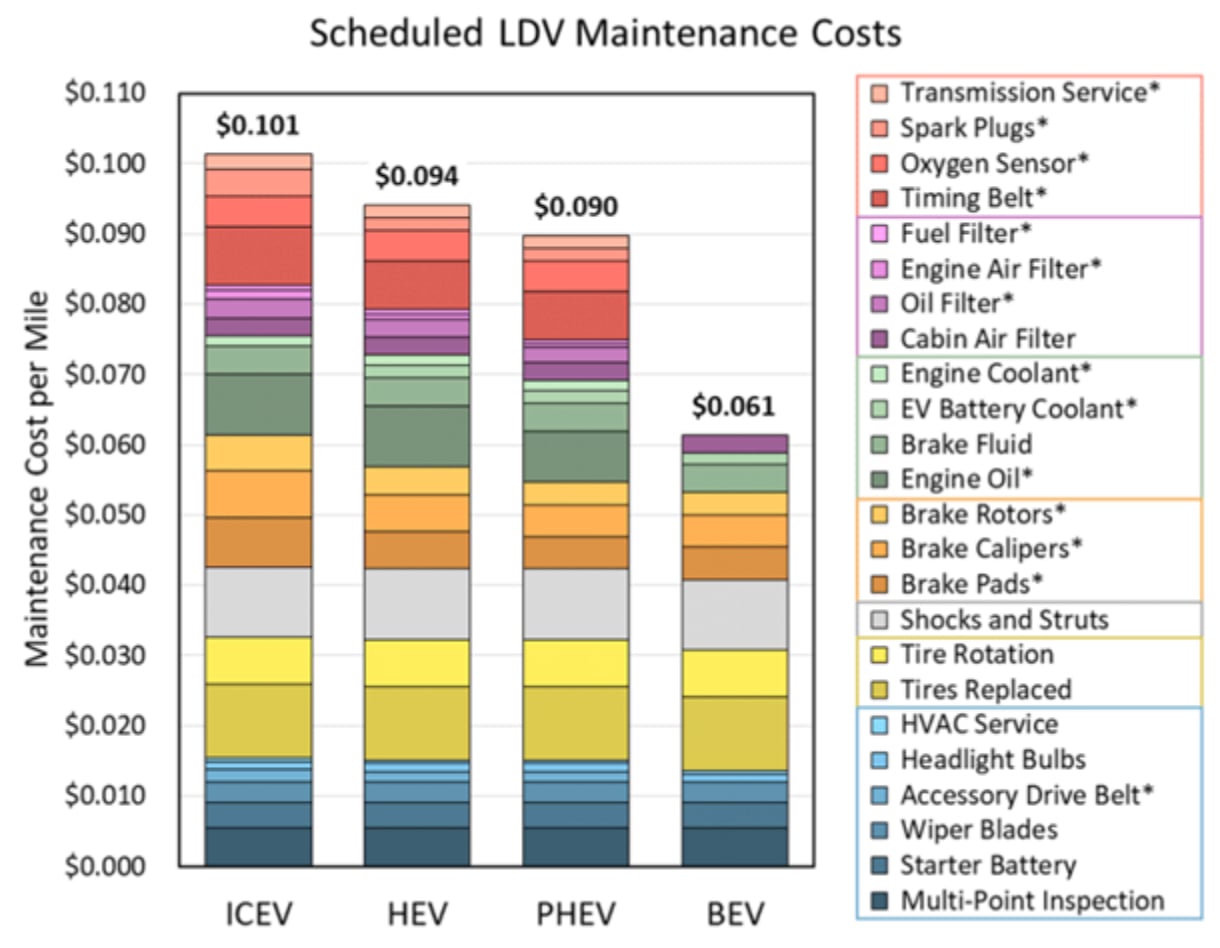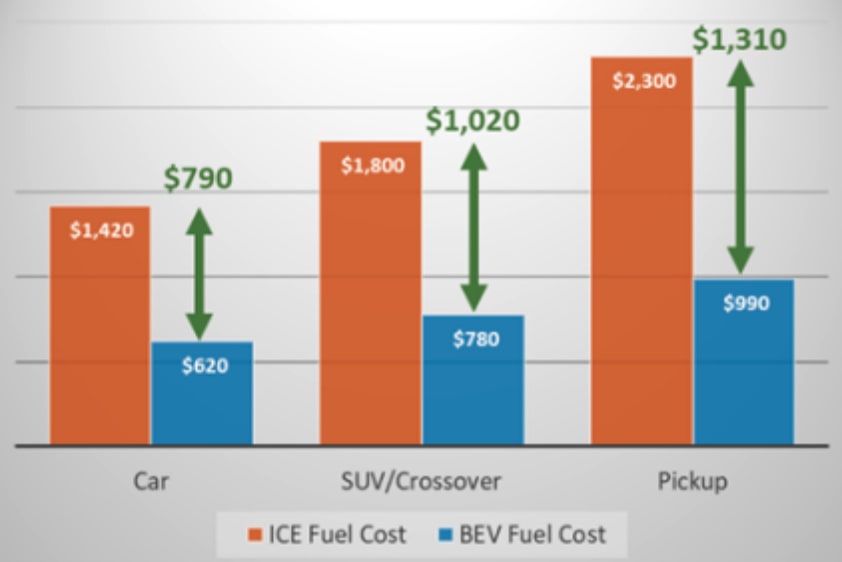Why Should I Get an Electric Car In 2023?

Planning on getting a new car? Have you asked yourself, “Why should I get an electric car?” Whether you’re worried about the purchase price, where to charge, or performance, 2023 should be the year you put those concerns to rest. Electric vehicles (EVs) and chargers have come a long way even in the past couple of years. In this post we’ll walk you through what you can get out of an EV in 2023, and what it would cost you compared to a gas-powered vehicle.
How Much Do EVs Cost vs. Gas-Powered Cars?
The International Energy Agency estimates that 60% of vehicles sold globally will be EVs by 2030. As we approach that number, many new electric vehicle makes and models will hit the market. Indeed, the list of EVs on the market today versus two years ago has more than doubled. Additionally, the list of automakers moving to an all-electric lineup keeps getting longer: Volvo, GM, Mercedes, Audi.
For now, most automakers still have entry-level, gas-powered cars like sedans, trucks and vans that cost less than equivalent electric options. But the price difference between base-model electric cars and gas-powered vehicles nearly disappears when rebates get factored in.
Say you’re looking to buy a Nissan in California. Nissan’s entry-level sedan—the 2023 Versa—starts at $15,730, while its all-electric LEAF starts at $28,040. But knock off $7,500 in federal rebates and it’s $20,540. Add another $2,000 from the California Clean Vehicle Rebate Project, plus an additional $2,500 if you make under $135,000 as a single filer or $200,000 as a joint filer and it’s $16,040. That’s a net cost difference of just $310.
Enel X Way’s rebate tracker will help you find what’s available from your state and utility for both EVs and EV smart chargers. And remember that new incentives are rolling out all the time, so keep checking back.
Perhaps you live in a state without rebates and need a truck for work. Ford’s F-150 will retail for $34,445 in 2023. Their electric F-150—the Lightning—starts at $51,974. The F-150 Lightning qualifies for the full $7,500 federal tax credit, which brings the price difference down to $10,000. That $10,000 may seem like a premium paid to drive an EV, but recent research shows that the price difference evaporates over the course of the car’s life.
EVs Cost Less to Fuel and Maintain
The US Department of Energy published an in-depth study of the cost per mile to maintain different types of light-duty vehicles (LDVs). They found that battery-electric vehicles cost 40% less to maintain per mile of use in comparison to gas-powered vehicles. Over 100,000 miles, that’s a $4,000 difference.

Source: Energy.gov
Then consider fueling. In 2020, Consumer Reports found that on average, EVs cost 60% less to fuel than internal combustion engine vehicles (ICEV). At the time that amounted to $1,310 per year for pickup trucks.

Source: Consumer Reports
Average national gas prices when the report came out were $2.16 a gallon. In November 2022 they were $3.69 a gallon, which would put annual fuel cost savings at $2,239. Driving 15,000 miles per year, that’d put gas savings at nearly $15,000.
After 100,000 miles, the F-150 Lightning costs around $9,000 less than the gas-powered F-150. These figures are in line with Consumer Reports’ finding that “typical total ownership savings over the life of most EVs ranges from $6,000 to $10,000”, including the purchase price.
How Easy Is It to Keep Your EV Charged?
Smart EV chargers like the Enel X Way’s JuiceBox make the charging experience easy. With their ability to charge EVs up to 9x faster than standard 120V plugs and their versatility for home or public charging, Level 2 smart chargers are revealing how different the experience of “refueling” is when you drive an EV.
In 2022, there was roughly one public Level 2 or Level 3 Fast Charger per 12 EVs. That’s somewhere between 12 and 25 more plugs per EV than gas pumps per ICEV. That figure doesn’t include Level 2 smart home chargers, which in all likelihood make up the majority of chargers in the country, as 80% of EV drivers say they charge primarily at home. With so many public charging station locations, it is far more convenient than gas stations, keeping your EV charged in 2023 isn’t just cheaper than average gas price—it’s far easier.
EVs Provide a Better Driving Experience
EVs first emerged in two types: the understated hatchbacks (e.g., Nissan’s LEAF), and the speed-racing, polished luxury sedans (e.g., Tesla’s Roadster). These worked wonders for proving how great a driving experience EV’s could offer. They were safe, quiet, smooth and even the hatchbacks had remarkable acceleration for their size. But luxury cars and compacts make up a relatively small portion of what Americans drive. In 2019, 48.5% of cars sold were SUVs of some type, and another 17.6% were pickup trucks.
The EVs hitting the market in 2023 and beyond are beginning to match those numbers. Car and Driver’s 2022 Editors’ Choice was the Ford Mustang Mach-E, a beautifully spacious crossover SUV with the speed and performance befitting the Mustang name. It shares the market with other award-wining crossover electric SUVs like Tesla’s Model Y, Hyundai’s Ioniq 5, the Kia EV6 and the Volkswagen ID.4. In pickups, Ford’s back-ordered 2023 F150 Lightning just got named 2023 MotorTrend Truck of the Year, competing with Rivian’s R1T and the GMC Hummer EV Pickup.
What’s compelling truck enthusiasts across the country to go electric, besides cost? Torque, horsepower and power output capabilities. The F-150 Lightning has 775lb-ft of torque to the base model F-150’s 265lb-ft, and 563HP to the F-150’s 290HP. Plus the Lightning’s battery pack has the ability to power 10 120V outlets and one 240V outlet simultaneously, or even provide backup power to your whole home!
EVs Emit Far Less Carbon Dioxide
The latest research finds that electric sedans, SUVs and pickup trucks in the US have 64% lower greenhouse gas emissions than gasoline-powered vehicles in the same class, cradle-to-grave. That includes all emissions related to “fuel production, processing, distribution, use…vehicle and battery manufacturing, recycling, and disposal.”
That 64% accounts for the different electricity sources used across the country, not just parts of the country with higher ratios of renewables in their generation mix. And that number is only going up as utilities bring more renewables online, making EVs better for the air you and your community breathe.
